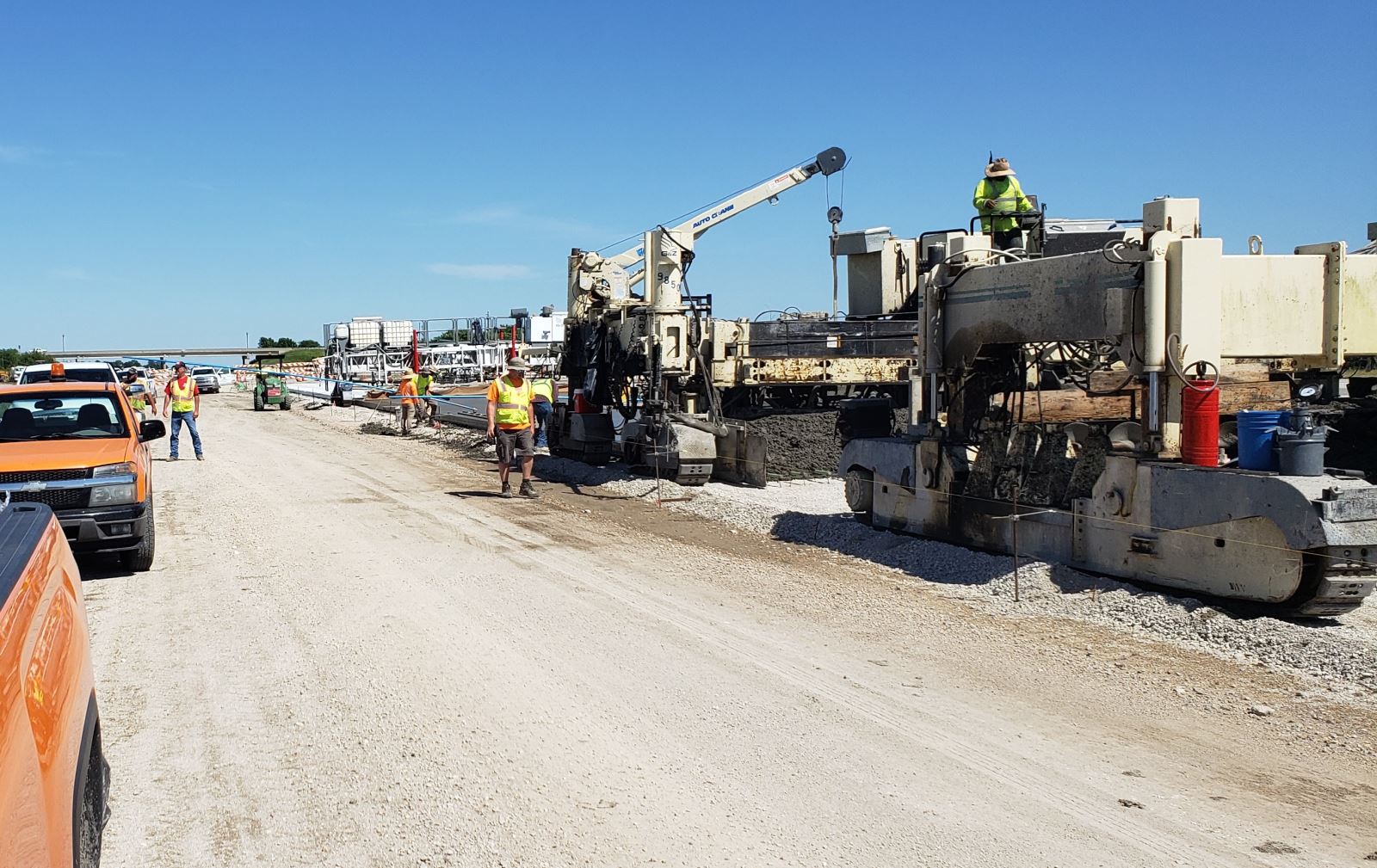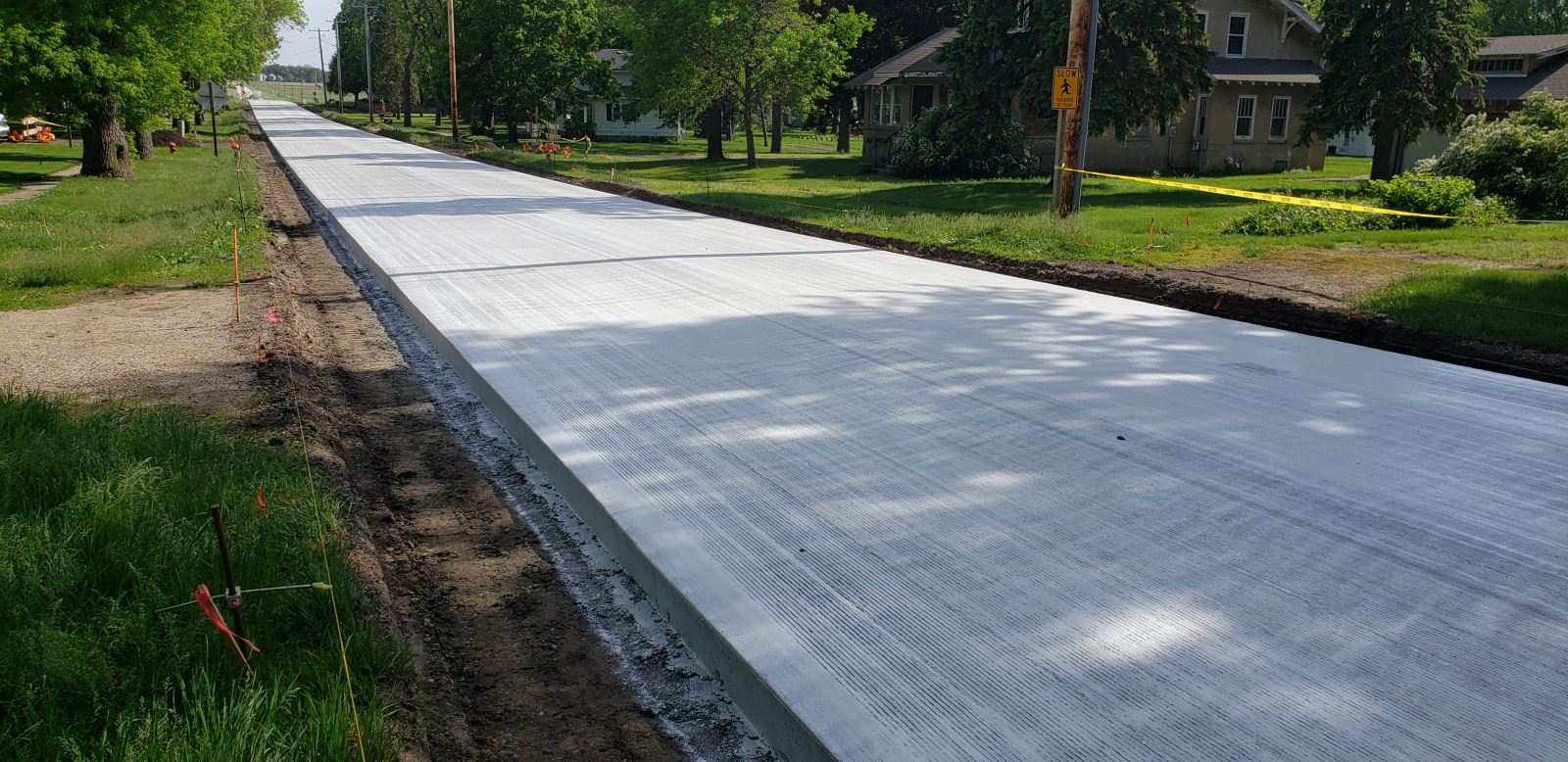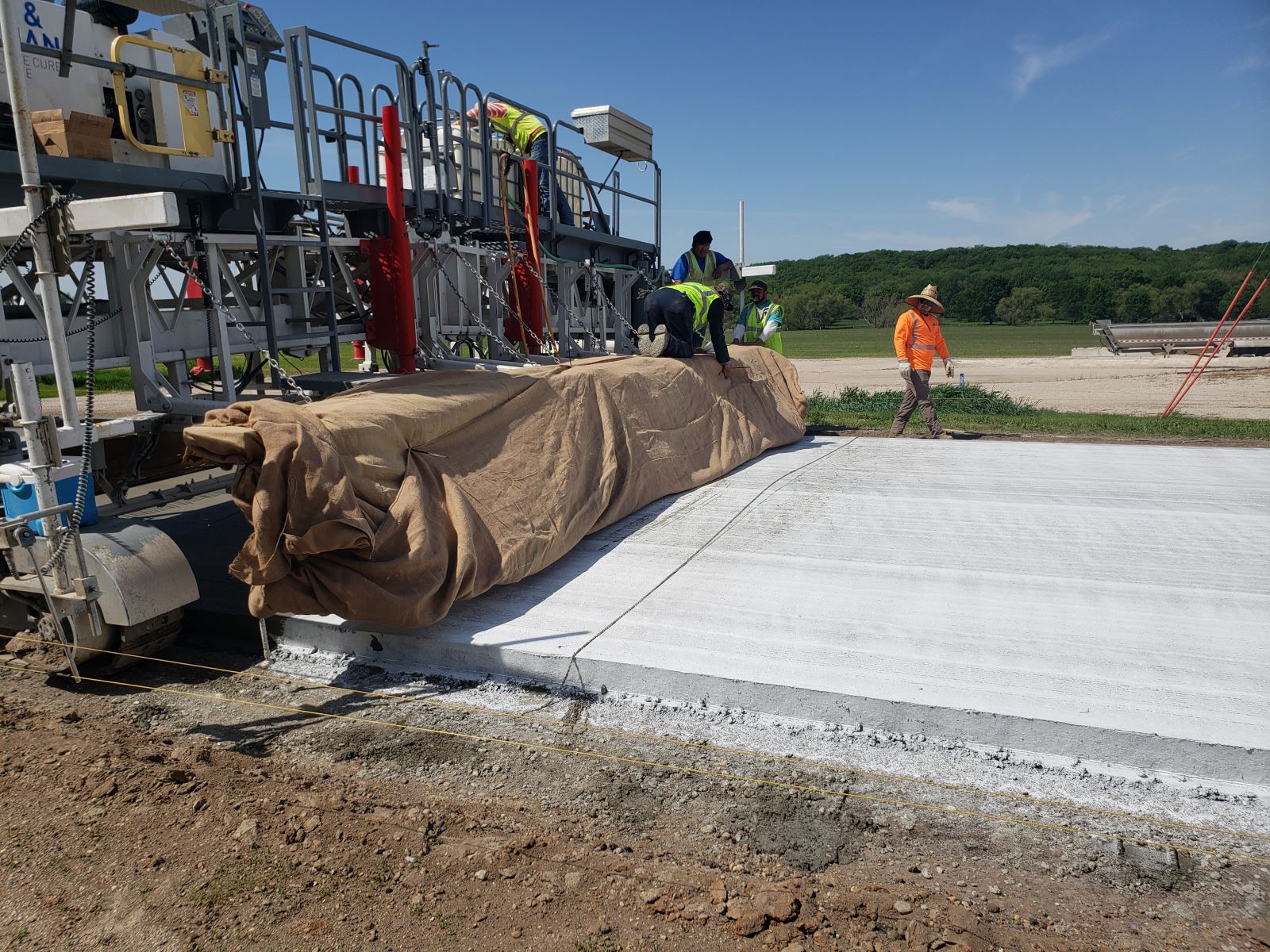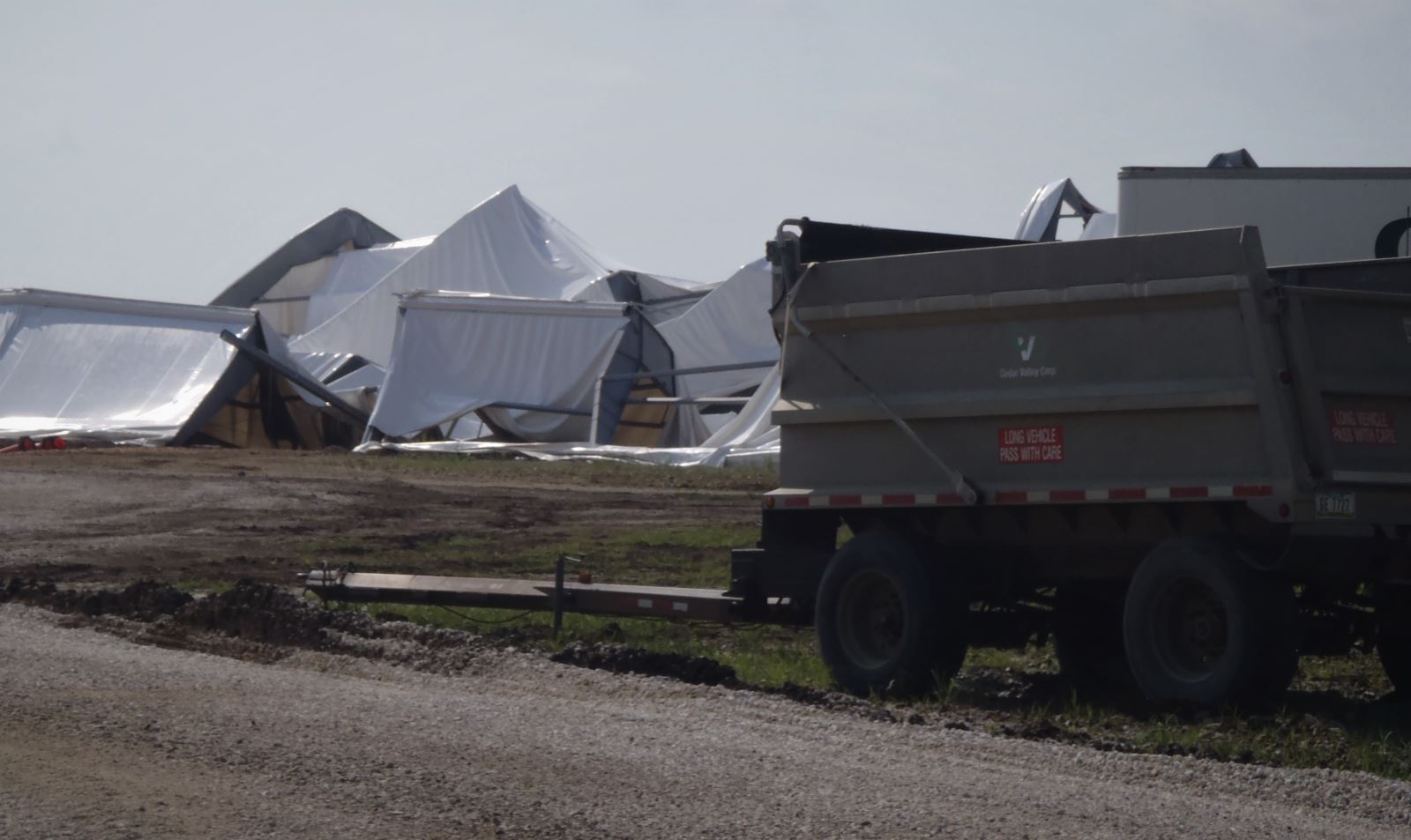The successful four-day trial in the fall of 2019 led to implementing a PEM mix with 499 pounds of cementitious/cubic yard into the 29,112 cubic yards of mainline and 18,221 cubic yards of shoulder paving in 2020. This change for calendar year 2020 paving saved approximately 828.3 tons of cementitious material. This project was the first to use a PEM mix for mainline paving in Iowa.
In the end, 26 contract modifications were issued, adding 2.4 million dollars of extra work, to this original 30 million dollar project.
Finally, Cedar Valley is extremely proud of our safety record on this project. We had no loss-time injuries and no recordable vehicular accidents with almost 67,500 man-hours of exposure. CVC earned 70 percent of the smoothness bonus and 100 percent of the thickness bonus.
US Highway 20 Webster County
Cedar Valley Corp. (CVC)’s Webster County-US Highway 20 contract won the Iowa Concrete Paving Association’s “Best “award in the Divided Highways Rural category. This project reconstructed both the eastbound and westbound lanes of a portion of US Highway 20 west of Webster City, Iowa. CVC was very pleased to win 1st place in this prestigious and crowded category.
 The total length of the project was 5.27 miles. CVC crews placed nearly 228,000 square yards of ten-inch-thick paving, which included 71,423 square yards of tied concrete shoulders. The project also included a large median crossover, and paved side road intersections.
The total length of the project was 5.27 miles. CVC crews placed nearly 228,000 square yards of ten-inch-thick paving, which included 71,423 square yards of tied concrete shoulders. The project also included a large median crossover, and paved side road intersections.
CVC’s Highway 20 contract was let on February 18, 2020, with a specified Late Start Date of April 1, 2020. Contract provisions included a 100 working day clause when Highway 20 was in head-to-head traffic mode. An additional 30 working days were allowed when single lane closures were utilized. Liquidated damages of $3,000 per working day were assigned to each situation.
To earn the No Excuse Road Opening Bonus the contractor was required to have all US 20 lanes, shoulders, and ramps open to traffic with no further lane closures by November 16, 2020. Based on the working days assigned to this project, CVC personnel built a viable work schedule for this project prior to the bid submittal. By doing so we determined that we needed to allow for a potential ten days of $3,000 working day penalty, or $30,000, built into our bid. After many adjustments for extra work, we were assessed nine and one-half days of liquidated damages- so our calculations proved accurate. The entire project was open to unrestricted traffic on October 30, 2020, thereby earning the No Excuse Bonus.
The biggest puzzle on this project was the median crossover pavement which was to be placed during the first stage of the project. The intention of the crossover and temporary ramp connections were two fold. One, they enabled traffic to access the Highway 17 ramps, and 2) they also enabled CVC to move the crossing ramp traffic from one end of the detour to the other end while a mainline gap in this area was paved.
Prior to building this detour we questioned the IDOT about how the new mainline would be staged in this area. Their response was to pave the detour per plan and move on with the project. However, after the existing pavement was removed and the new survey was established, it was determined that the new pavement elevation would be substantially different than the existing. It turns out that during the design phase the IDOT had failed to consider that one lane had had an HMA overlay at some point in time.
The first solution to this elevation bust was to saw and remove an eight foot wide portion of the detour pavement so the new mainline six foot shoulder could be placed at the correct elevation. This work also had to be staged to facilitate traffic movements. Unfortunately, only removing eight feet did not totally resolve the design issue. Eventually it was determined that additional detour pavement would have to be removed and replaced since the new shoulder had a required four percent cross slope and therefore did not properly match the differing detour cross slope.
To say that the IDOT and CVC field staff spent an inordinate amount of time resolving this mess would be an understatement. The IDOT did acknowledge their error and subsequently granted us extra working days to complete this corrective work.
CVC bid this project with the intention of using a concrete mix with a 20% flyash substitution rate. Unfortunately, the first Type C flyash furnished by our supplier caused erratic air issues. We fought through the first day of paving with this ash and then demanded that our supplier furnish ash from a different source. Based on planning to earn the No Excuse Road Opening bonus, we elected to pour about 6,200 cubic yards with straight cement while our flyash supplier replaced their ash from a different source. We encountered no inconsistent air issues with the new ash.
To expedite the project, CVC chose to pave the full depth outside six-foot-wide shoulder integrally with the twenty-four-foot wide mainline. The project contained two vertical curves in each direction. In these areas the outside shoulder cross slope changed as the mainline rotated in and back out of the super. CVC bought a new crowning mechanism that was placed at the six-foot joint location to accommodate the varying slopes. Furthermore, to doubly ensure that our G+Z paver would properly place this pavement, we chose to stop paving at the start of the first vertical curve while we spent half a day dry running the area to double check the data that we had programmed into the crowning computer. This extra effort paid off as we achieved unbelievable smoothness.
IDOT Resident Construction Engineer Kenneth Howe, PE, wrote this with regard to CVC’s achievements: In closing, we feel that choosing concrete pavement for this project was the ideal solution for the scope of this project and consider our organization fortunate to have had Cedar Valley Corporation as the prime contractor. They were receptive to our issues, quick to adapt and very skilled at their craft. Based on our experiences, I would recommend Cedar Valley Corporation for the American Concrete Paving Association’s National Award.
Finally, Cedar Valley is extremely proud of our safety record on this project. We had no loss-time injury and no recordable vehicular accidents with over 41,000 man-hours of exposure. CVC attained almost eighty-three (83) percent of the maximum MRI smoothness incentive on the mainline paving. This portion of US 20 is rumored to be the smoothest paving ever placed in Iowa. CVC earned 100 percent of the thickness bonus.
CLAY COUNTY-GOLD WINNER
In a time when most small-town main streets have been by-passed by major roads and highways, Webb and Gillet Grove, IA, remain an exception. Cedar Valley Corp. (CVC)’s Clay County M54, Iowa job was an 8.54-mile-long stretch of mostly unbonded concrete overlay that ran right through the main street of these two small towns. Clay County Engineer, William D. Rabenberg described the Webb City portion of the project this way: The PCC pavement overlay was full depth, partial depth, rural intersection work, City intersection work, sidewalk transition sections, gravel shoulders, paved driveways, gravel driveways, striping, change orders for adding additional paving items, non-standard sidewalk, non-standard driveway paving, parking lot paving, and ADA compliance at intersections within the city limits of Webb. This project could not have been more varied in its depth, section, design, and integration into the City of Webb. Several items had to be added and field engineered. Cedar Valley was very accommodating for all of the changes. The main street of Webb, IA was M54 so that creates quite a logistical coordination effort to do a PCC pavement full depth section down the center of town. Driveway approaches had to be done after mainline paving was complete, which impacted residents all along the project.
The agricultural state of Iowa requires high quality Farm to Market roads to get its products safely and efficiently to market. The majority of this project was a concrete overlay but included full depth paving through the two small towns which added considerable complexity to the project. CVC is very proud that our Clay County 103,146 SY overlay project won the Iowa Concrete Paving Association’s top prize for PCCP Overlays (County) among the ten projects nominated in this category.
The project was let on February 18, 2020. This contract specified a late start date of May 11, 2020 and was assigned 100 working days. Clay County personnel and all the local residents were pleasantly surprised and extremely appreciative when CVC amazingly completed the project in only fifty-eight working days.
CVC gave careful consideration to the paving sequence on this project. Clay County Road B63 crossed the M54 project 3 miles north of the south end of the job. CVC chose to begin paving this project from the south end, north as far as the B63 intersection. This action allowed us to pave a one-half mile of full depth nine-inch pavement through the small town of Webb early on in the project, which enabled us to successfully stage a mainline access gap, six intersections, and also permitted our driveway and sidewalk subcontractor to get a quick start. Also, the B63 intersection was required to remain open at all times. Since we paved to the centerline of the intersection prior to moving to the north end of the project this eliminated a paving gap.
Then we moved our paving spread six miles to the north end of the project and paved south back to B63. B63 was also the most logical and economical location for our plant site since it was the only paved crossroad on the entire project. Paving from the north also enabled necessary access staging in the small town of Gillett Grove.
Obtaining pavement smoothness on county overlay paving projects is always challenging since the county road system in Iowa was not built, nor ever required, to meet the same high design standards that are applied to primary and interstate projects. Relaxed design on vertical and horizontal curves ultimately builds roughness into county overlay projects. This project contained two 6 per cent elevated curves and one 4 per cent elevated curve. Additionally, there were numerous horizontal curves as the overlay followed the existing county road profile. Based on the severity of the two superelevated curves, Clay County chose to add four-foot-wide concrete shoulders in those areas.
Despite the design challenges, CVC still attained a two tenths blanking band reading of 2.26 inches per mile. This earned CVC 62.9 percent of the maximum smoothness incentive.
A major obstacle was providing access to the many local property owners. The traffic control plan for the job specified that the contractor was required to provide local access to landowners and residents along the project. The most difficult traffic challenge was to keep the various property owners informed as to when their driveways would be impacted, as the only access property owners usually had was by the county road CVC was paving.
As the job progressed, each resident received an update from CVC’s project manager that informed them of our paving schedule. During the paving operation CVC personnel worked with property owners on a daily basis so they would know when their access would be affected.
 CVC personnel explained that maturity testing would be used to determine opening pavement strength. Residents understood that the maturity concept is a nondestructive and efficient method to determine acceptable opening concrete strength in the shortest amount of time. It was also emphasized how important it was for residents to stay off the pavement until it had reached opening strength.
CVC personnel explained that maturity testing would be used to determine opening pavement strength. Residents understood that the maturity concept is a nondestructive and efficient method to determine acceptable opening concrete strength in the shortest amount of time. It was also emphasized how important it was for residents to stay off the pavement until it had reached opening strength.
Consequently, every night, after the paving operation ceased, access was reestablished to all affected property owners where opening strength had been reached. The stringline was removed, and the existing driveways were opened to local access.
The property owners were very appreciative that maturity testing enabled their access to be restored as quickly as possible. Cedar Valley’s excellent communication with property owners allowed us to work through the difficulty of maintaining local access and eliminated premature access and damage to the new pavement.
Finally, CVC is proud of our safety record on this project. We had no loss-time injuries and no recordable vehicular accidents with over 13,600 man-hours of exposure.
MARSHALL COUNTY-SILVER WINNER
Cedar Valley Corp. (CVC)’s Grundy/Marshall County, Highway 14 contract won the Iowa Concrete Paving Association’s “Best “award in the Overlay (state) category among ten entrants. CVC was very pleased to receive this honor, which served to aptly reflect the exceptional effort of our paving crews.
The length of the project was 11.23 miles and CVC crews placed almost 213,000 SY’s of paving. The project included full depth sections at each end of the project and on both sides of an existing bridge. Eleven side-road intersections were also paved. The vast majority of the project called for a nominal 6 inch thick, thirty-two-foot-wide overlay. The over 206,000 SY’s of overlay pavement consumed almost 36,500 CY’s. of concrete.
While putting the bid together for the Highway 14 project, CVC estimators came up with three suggestions for change that we felt would make the project better.
.jpg)
The IDOT utilizes the software firm Infotech as its vehicle for bidding communications. Within InfoTech’s software is a Bid Express function. Bid Express allows a contractor to send questions to the IDOT about project plans and specifications prior to bid submittal. In the interest of fairness, all contractors have access to both the questions submitted and the answers given by the IDOT. First, CVC questioned the fact that a mere 45 working days had been assigned to stage two of the project. Upon further review, the IDOT agreed and reassigned Stage one to have 45 working days and Stage 2 to have 55 working days. This change moved ten working days to Stage 2, where the vast majority of the project was to be built.
Secondly, the IDOT had specified a two-foot pad line on this project. CVC successfully convinced the IDOT to add another one foot of pad line by addendum. This change greatly enhanced our ability to achieve outstanding smoothness on the project. Finally, we successfully requested that the IDOT modify the proposed joint detail so the 32’ mainline could be poured through the north 250 foot of mainline. These 3 pertinent suggestions for change by CVC resulted in a superior project for the IDOT.
Staging called for profile milling Highway 14 under traffic, utilizing flaggers and pilot cars. Instead, CVC chose to perform this work during a stage where live traffic was already being detoured off of Highway 14. This proactive action saved the citizens of Iowa $168,720.
Plans called for sawing 5 centerlines and crosscuts every 6 feet. Since CVC was paving a 32 foot wide segment, this meant there would be 54,560 lineal feet of saw cut per mile. This was much more sawing than our normal saw crew could complete in one day.
Our solution was to train members of our fine grade to saw. Since this was an overlay project, thus requiring no subgrade preparation, the fine grade crew was available. This proactive action kept our sawing caught up.
Obviously the very next issue we tackled was how to seal the many joints on this project. The first step we took was to rent a second tar kettle so we could eliminate the time required to heat the hot pour when the first kettle was empty. This allowed our seal crew to seal continuously. Even so the sealing operation quickly fell behind. Ultimately, we hired a subcontractor to seal over two miles of pavement, which enabled the sealing to keep up and our grading subcontractor to start on schedule.
On August 10, 2020, disaster hit as a severe derecho swept across Iowa. A derecho is a widespread, long-lived windstorm. CVC quit paving at 8:30 am that morning with an eye on the weather and covered the pavement with burlap. The heavy rain and punishing winds hit at 11:30. The burlap was quickly blown into a nearby field while driving rain completely pounded the texture out of the new paving even though it was already three hours old. The entire area around CVC’s Highway 14 job sustained substantial property, utility, and crop damage. A building located at CVC’s plant site was totally destroyed. As a result we were forced to diamond profile six hundred feet of thirty two foot wide pavement to reestablish acceptable texture and crews spent much of the next week picking up debris.
CVC is proud of our safety record on this project. We had no loss-time injuries and no recordable vehicular accidents with 16,267 man-hours of exposure. CVC earned 81.5 percent of the maximum zero band smoothness incentive. This project contained six fairly substantial vertical curves and a bridge. Most of the curves were located in the first two and one-half miles of the project. If one were to leave the curve numbers out, CVC attained almost 95 percent of the maximum smoothness incentive on the rest of the paving.
Resident Construction Engineer Dustin Skogerboe, PE, wrote this about CVC’s achievements: This project presented numerous challenges and was under a tight schedule due to the high-volume highway being closed for the duration of paving. CVC had to coordinate with property owners, businesses, two different counties, emergency management and other entities during the project to ensure there were always crossings available and access for residents. The existing pavement had significant rutting which made it difficult to mill consistent cross slopes for the PCC overlay. CVC was very proactive by preparing milling surface profiles in advance. They were very diligent in running depth checks and maintaining thickness and smoothness for the overlay pavement. They were consistently above the thickness and smoothness requirements by specification and qualified for incentive on both. There was an issue with some vehicles removing traffic control closures and driving over plastic concrete, as well as some damage from the Derecho storm in August.